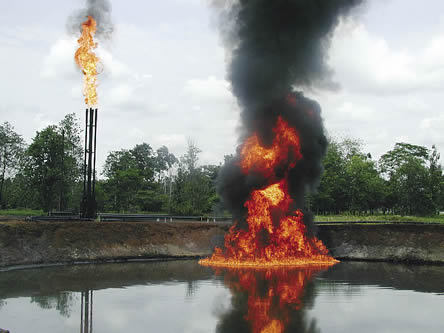On July 7, some 18 million people tuned into eight simultaneous Live Earth concerts staged worldwide featuring Sting, Al Gore, Kanye West, and a range of other celebrities preaching about our planet’s dire environmental crisis. The concerts were seen as a milestone in public awareness about climate change.
For 60 seconds during the three-hour broadcast, viewers were shown images of pristine jungle next to toxic smudge-filled rivers as actor Martin Sheen explained the importance of the Amazon rainforest to our global health, and the jungle’s unfortunate continuing destruction.
“One place is at a turning point,” Sheen says halfway into the spot. “In Ecuador, there’s a monumental struggle for justice and environmental clean-up that needs our support.”
That turning point is Yasuní National Park, one of the world’s most biodiverse regions and home to a vast untapped oil field. In an unprecedented move, Ecuadorian President Rafael Correa recently announced that he would leave the area untouched if the international community would be willing to give the Ecuadorian people half the field’s potential worth in return – $350 million annually for 10 years.
“The international community has to compensate us for the immense sacrifice that a poor country like Ecuador would have to make,” President Correa has said.
He’s given the world one year: Come up with the pledges and the oil stays in the ground forever. If not, the drilling begins.
Yasuní lies in eastern Ecuador near the Peruvian border, a six- to seven-hour boat ride away from the nearest main road. Labeled a UNESCO Biosphere Reserve in 1989, the 2.5 million acre region holds 44 percent of the Amazon’s bird species; within just two acres of the park, there are more varieties of trees than in all of North America.
The southern part of Yasuní is already being drilled, but a northern portion, known as the ITT (Ishpingo, Tambococha, and Tiputini) Block, home to a quarter of Ecuador’s total petroleum reserves of one billion barrels, has managed to stay untouched because of protests by environmental groups.
Drilling would mean disaster: logging, pipeline construction, eventual spills, and, because ITT’s oil is a heavy grade 14 crude, excessive amounts of toxic water dumped into the nearby Yasuní and Napo rivers.
People’s lives are also at stake. Three of Ecuador’s nomadic indigenous groups (the Tagaeri, Taromenani, and Oñamenane) live in voluntary isolation in the region; putting oil workers and machinery on the group’s doorstep risks their extinction. The Hoaroni people live nearby; their land would become worksites, their drinking water polluted. The rest of the world would also feel the effect eventually, since carbon emissions from the oil will contribute to climate change.
In the past, even activists fighting the ITT drilling knew that they were only putting off the inevitable. Then came Rafael Correa. Though not particularly “green,” the president appointed Alberto Acosta – a well-known environmental advocate – as his first energy and mining minister, opening a door to a proposal that local NGOs had developed over the years.
“We knew that the only safe and viable option was to leave the oil in the ground.” says Jose Proaño of the Quito-based environmental rights group, Acción Ecologica (Ecological Action), one of the organizations that developed the ITT proposal. Acosta convinced Correa to try it.
With a one-year deadline set, the clock is now ticking. Yet the plan’s details remain foggy.
 REUTERS/Guillermo GranjaThe Yasuní River’s quiet way of life could be destroyed if oil drilling begins.
REUTERS/Guillermo GranjaThe Yasuní River’s quiet way of life could be destroyed if oil drilling begins.
Three of Ecuador’s indigenous groups live in voluntary isolation on the river.
“It’s going to be a huge challenge,” says Ruben Flores, executive secretary of the government’s new Technical Sub-Secretariat in charge of developing the ITT plan.
The idea is that bonds representing one barrel of the park’s oil will be sold at $5 a pop; local and international NGOs will secure small-time buyers while the government works on large-scale international cooperation (foreign governments, international institutions, etc.) to purchase the rest.
But, according to Flores, the difficulty is making the deals legally binding so that future governments can’t just begin drilling (at least without facing the wrath of millions of angry barrel owners), while maintaining some wiggle room.
“If we can’t get the $3.5 billion, we will have to drill,” Flores explains. “So there must be mechanisms for giving back the money already contributed if we only get halfway.”
Should the goal be reached, Correa talks of putting the contributions towards the country’s $15-billion international debt. But local groups want the money to pay for sustainable agricultural programs, environmental remediation for past drilling messes, compensation to Amazonian indigenous groups, and funding for alternative sources of energy.
“Basically, nothing is certain yet,” Flores admits.
In South America, business has always overshadowed biodiversity. Mining and oil and gas extraction continue to keep economies here afloat. Yet profits have always lined the pockets of national oligarchies and transnational executives, while the continent’s majority has sunk into deep poverty.
Current leftist leaders – Venezuela’s Hugo Chavez, Bolivia’s Evo Morales, and Ecuador’s Correa – have continued to base economic growth on environmental degradation. But government priorities have shifted. Revenues now fund social programs, meaning these governments’ popularity is founded on anti-green policies.
Morales nationalized the hydrocarbon sector in 2006, upping state income from $250 million to $1 billion annually, making him one of the most popular presidents on the continent. Venezuela’s oil wealth grounds Chavez’s self-proclaimed socialist revolution, enabling free literacy programs and medical care. He’s now a leftist hero worldwide.
Oil in Ecuador has generated over $80 billion in revenue since its discovery in the 1960s. Thirty-five percent of Ecuador’s annual budget is oil-based, as South America’s fifth largest producer churns out 550,000 barrels daily.
Yet 65 percent of the Ecuadorian population is impoverished, and 17 percent live in extreme poverty. The nation has suffered extreme environmental, health, and social damage from the oil industry.
The Ecuadorian people – primarily the indigenous living in affected areas – are now at the forefront of the struggle against the oil industry. Ecuador is in the middle of a historic $6-billion lawsuit against Texaco/Chevron for dumping more than 18 billion gallons of toxic waste over 25 years. And the country threw out Occidental Petroleum last year for breach of contract.
Some analysts and activists want to see the Yasuní plan as a sign of a 180 degree shift in oil policy, taking Ecuador towards a post-petroleum future. But the country is still far from cutting off the drill that feeds it.
“There is talk here about Yasuní as the first step toward not beginning any new oil drilling projects,” says Javier Ponce, a sociologist for the Ecumenical Project Committee in Quito. But the government has made no promises. There is still a primary dependence on oil.
In the last year, several highly publicized studies have been released warning us about our planet’s catastrophic future if our current rate of oil consumption continues. Pop culture, too, has jumped on the conservation bandwagon – meaning, intentionally or not, Correa had impeccable timing.
“If Ecuador had done this a year ago, it might have gone unnoticed,” says Kevin Koenig, Quito-based Northern Amazon program coordinator for Amazon Watch. “People in countries like the US are just now waking up to climate change. This gives them a way to contribute to a solution.”
Ecuador’s move is, technically speaking, unprecedented. Though similar to programs that have sold acres of rainforest to avoid deforestation, this kind of nature purchase has never been tried for an area that holds billions of dollars of known oil reserves.
In early July, the Ecuadorian press reported that Bolivia’s Morales sent a letter to President Correa, congratulating him on the idea and asking for Ecuador to help Bolivia establish a similar campaign, presumably for Bolivia’s Madidi National Park, which, like Yasuní, is both biodiverse and oil-rich. But there has been no public announcement in Bolivia regarding this idea, and by the end of July, Morales was moving forward with plans for drilling.
 Courtesy Amazon Watch Ecuador may not yet be ready for a post-oil economy. Petroleum revenues account for
Courtesy Amazon Watch Ecuador may not yet be ready for a post-oil economy. Petroleum revenues account for
35 percent of the government’s budget.
So while the idea has promise and may prove catchy in the region, it is too early to determine whether this is a watershed for habitat and climate protection. “This is a commendable proposal for a country that is looking to both protect its biodiversity but also meet its economic needs,” says Graham Saul, International Programs Director for Oil Change, a US-based NGO that works towards a non-oil, clean energy future. “But there are still too many concerns about the plan’s viability for us to know what impact it’s going to have on Ecuador and around the world.”
Flores is optimistic. “We’ve had promising meetings with government officials from Spain, Norway, Germany, and Switzerland, as well as with the United Nations and Inter-American Development Bank, who all want to contribute.”
Within Ecuador, ”Oil Companies Out of Yasuní” graffiti line city walls, and the newspaper El Comercio, not known for progressive politics, found that 80 percent of those surveyed are in favor of the proposal.
“We’ve got people saying, ‘I was going to buy a car this year but I want to put the money towards ITT instead,’” says Acción Ecologica’s Proaño. Others want to sell their family pig in order to buy barrels.
But in and outside of Ecuador, there’s anxiety about the future.
Flores insists his post’s creation – with financial resources to back it – is a “strong sign” that the government is going to put its full force into achieving the goal. And though Correa was before at pains to warn that he might have to end up drilling anyway, his commitment to the proposal seems to have grown as the international spotlight brightens.
“We’re hoping that Correa won’t be able to turn back because there will be too much backlash,” says Koenig.
The state oil company, Petroecuador, is not convinced that Yasuní is a done deal. Executives have said they’re willing to sit tight until next year when a final decision is made. But knowing full well that the government’s backup plan is to give Petroecuador ITT drilling rights, oil execs sit salivating at the door, waiting for the world to decide how much Yasuní is really worth.
Jean Friedman-Rudovsky, a Bolivia-based freelance reporter, has contributed to TIME and The Economist, and is the co-founder and co-editor of the online journal Ukhampacha Bolivia.
We don’t have a paywall because, as a nonprofit publication, our mission is to inform, educate and inspire action to protect our living world. Which is why we rely on readers like you for support. If you believe in the work we do, please consider making a tax-deductible year-end donation to our Green Journalism Fund.
DonateGet four issues of the magazine at the discounted rate of $20.